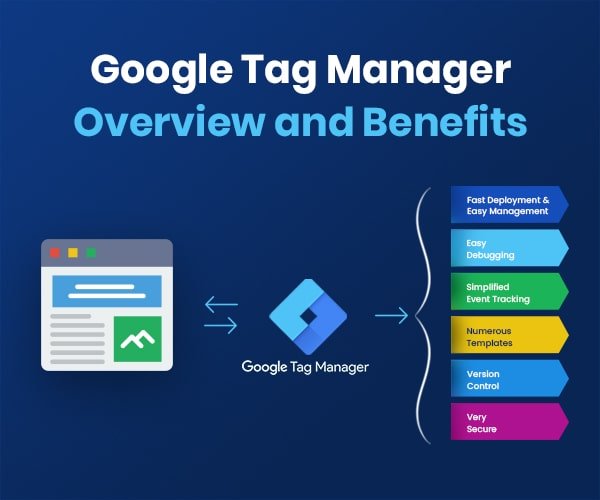Google Tag Manager (GTM) is a free tool provided by Google that enables digital marketers to manage and implement marketing and analytics tags on their websites without needing to modify the code. With GTM, marketers can track website data and analyze user behavior, making it easier to make data-driven decisions and improve the overall user experience. This article will discuss some of the benefits of using Google Tag Manager.
Is Gtm Difficult to Use?
Even though GTM is built for non-programmers with simple capabilities (such as editing tags in the GTM interface and publishing changes with a single click), the program still requires some attention. You might not be conversant with every programming language. Before we discuss the advantages of GTM, let’s go over some jargon.
Tags – are snippets of code. These are used to communicate information in order to carry out a certain action on a webpage. In other words, these tags instruct GTM on how and what to do.
Triggers – determine whether a tag is active and operational. For instance, if you want a visitor to see a form when they enter your website, a trigger triggers the tag responsible for displaying the form.
Variables -These are the information required for Google Tag Manager to correctly run tags and triggers.
GTM Advantages
- Simple to Use – The fact that no programming experience is necessary is one of Google Tag Manager’s key features. Without the need for intricate website coding, almost anybody can quickly update websites, add new tags, test each change, and deploy tags. By providing you and your team more control and streamlining your process, you can accelerate launch timelines and give your IT department the time it needs to concentrate on more crucial issues, like the reasons why your website is loading so slowly.
- Enormous time saving – GTM saves you time because it lets you add tracking codes on your own. No longer do you need a marketer to send tracking code to a developer and then wait a week for the code to be installed because the developer was busy. You won’t have to send and receive emails when you need to keep track of more events during that week. The GTM platform lets you add, edit, and remove all tracking codes, also called “tags.”
- It’s all in one location – Recall the toolbox comparison we did earlier. Everything is centralized with GTM. The necessity to identify specific JavaScript code snippets in a website or app’s source code to add, remove, or modify content is a thing of the past. Now that everything is in one location, human mistakes like missing some codes and providing false data are no longer an issue.
- Problem-solving is simpler – The convenience of having everything in one location makes it simpler to identify and fix tag errors—even before they are published. In addition to providing information about triggers and in-depth details about the data contained within tracking tags, GTM’s Preview Mode automatically identifies which tags are functioning and which ones aren’t. Tag Assistant and Data layer Checker are two more useful GTM tools.
- Making templates is possible – GTM enables you to export all of your tags, triggers, and variables into a single file that you can use to build custom templates for frequently used programs. When you want to integrate the same Google Analytics event (such as page view tracking or outbound link clicks) for different clients, this can be useful. A feature called Custom Templates, which enables the public to create and distribute freely usable custom templates, was also made available by Google at the beginning of 2019.
A lot of built-in tags in GTM can also be used for remarketing and conversions from Google Ads. Inexperienced team members can now customize tags without having to learn complex code or rely on a developer’s assistance.
- Self-event monitoring – With the use of a feature called auto-event tracking, which is included with GTM, users may automatically keep track of events (such as clicks, form submissions, and time spent on pages) without writing any specific JavaScript code. Once you’ve activated certain triggers, GTM will immediately begin listening for specific website activities, however, it takes some setup and isn’t as simple as clicking a button.
- Totally Free – It was kind of skimmed over earlier, but GTM is completely free and ideal for small and medium-sized organizations. Larger enterprises can upgrade to Tag Manager 360’s premium GTM version.
- Version management – In GTM, an archived version is always stored whenever you make a change. This makes it simpler to undo changes, roll back to a previous version, or undo changes you unintentionally published to a live site before the tagging was finished. Version control allows you the freedom to switch between versions without worrying about doing any lasting harm.
- Administration of Users and Permissions – GTM provides you complete control over who can make modifications and how. You can easily manage who has access to make modifications (like adding tags, macros, and rules to the website). Options include no access, read-only, editing, and publishing privileges.
- Clarity of mind – Are you concerned that the domains, IP addresses, or URLs in your tags may contain malware? Never worry! All tracking scripts are automatically scanned by Google, which suspends any scripts that match known malware right away.
Google Tag Manager’s Drawbacks
Although the GTM platform might be relatively simple to use, there is a steep learning curve. The main challenge for first-time users is having to completely understand all of Google Tag Manager’s functionality. This entails becoming familiar with a wide range of words and fundamental programming.
The different elements that are involved in using and managing tags might occasionally have issues. They might not fire when necessary, in which case some adjusting would be needed.
What is the Purpose of Gtm?
PDF Download Tracker – As part of their digital marketing efforts, many companies offer downloadable PDF tips or white papers. Without download data, it hinders strategy.
Google Tag Manager tracks PDF downloads and performance. Tracking downloads gives you actionable insights:
- Find your top and bottom downloads.
- Understand a download’s performance.
- Improve your download and track GTM progress.
Track Scrolling Actions – GTM’s capability to track scrolling behavior on your website and pages is another reason to utilize it.
Understanding how visitors use your website and engage with the content offers essential insight into site activity.
- What pages get the most interaction
- What information is more or less compelling?
- where scrolling users generally stop
You may create a detailed image of how most users scroll on each of your site pages using the GTM data that has been gathered. In exchange, you can develop a plan to enhance the user experience on your website.
- How you set up your website
- What you share
- Locations that need improvement
Link Click Tracker – Google Tag Manager has the advantage of being able to trace link clicks, particularly those that users made while on your website. Knowing a user’s clicking behavior in addition to just their scrolling behavior can tell you a lot about the path your visitors take.
- How does a user navigate across your website’s pages?
- Which calls to action (CTAs) are clicked on the most frequently?
But the real reason to utilize Google Tag Manager is to use the data it provides, not merely to comprehend link clicks.
- To increase conversions, examine pages with a lot of clicks or refresh pages with few clicks.
- Learn what makes a CTA have a high click rate and modify the copy for CTAs that get more clicks.
Follow-up form submission – Every business website should have forms; whether it’s for registering for an event, answering a survey, or subscribing to a newsletter, each form has a distinct purpose. GTM accurately logs form submissions.
Why track forms with Google Tag Manager?
- Report website traffic from form entries
- The number of forms filed can be used to gauge the effectiveness of a campaign.
Conclusion
Google Tag Manager is a powerful tool for digital marketers, providing a range of benefits, including simplified tag management, improved website speed, enhanced data accuracy, increased flexibility, better collaboration, improved user experience, and increased ROI. With GTM, you can manage all of your marketing and analytics tags in one place, and make data-driven decisions.
Frequently Asked Questions
Google Tag Manager is a free tool provided by Google that enables digital marketers to manage and implement marketing and analytics tags on their websites. With GTM, you can add, remove, and edit tags from a single interface, eliminating the need to modify the website code every time you want to make changes.
The benefits of using Google Tag Manager include simplified tag management, improved website speed, enhanced data accuracy, increased flexibility, better collaboration, improved user experience, and increased ROI.
No, you do not need to have coding skills to use Google Tag Manager. The tool provides a user-friendly interface that enables you to manage and implement tags without needing to modify the website code.
Yes, Google Tag Manager is a free tool provided by Google.
Yes, Google Tag Manager is compatible with a wide range of analytics tools, including Google Analytics, Adobe Analytics, and more. This makes it easy to integrate and manage multiple analytics tools from a single interface.




